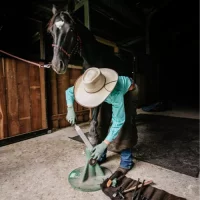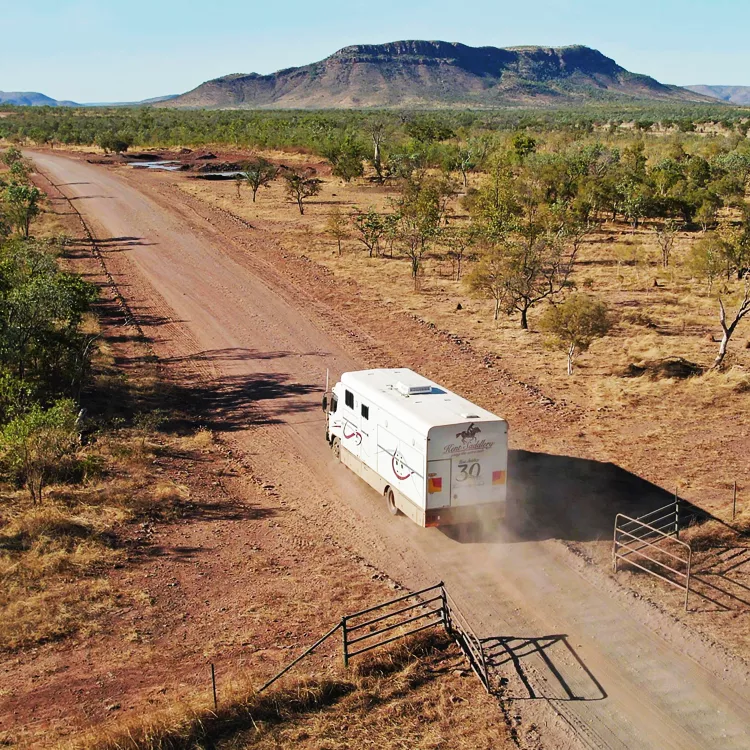Yarrie Station, Pilbara, Western Australia
The Coppin Family
“Pioneers of the Pilbara, since 1886”
In 2011, Lyle and Helen visited Yarrie Station for the first time. Over the years the Coppin family have bought saddles and gear so it was great to visit and “put faces to the names.”
Yarrie Station is situated North of Marble Bar in the midst of picturesque country crossed by the De Grey River. The Coppin family, Langtree, his wife Ann, and their daughter Annabelle live in the stone home built at the beginning of the last century by Lang’s great grandfather, who took up the original holding of Yarrie in 1886.
Walking into the covered dining area at Yarrie’s historic homestead feels like an immersion in times and events, people and places; the feeling intensified by the artefacts, furniture, paintings and posters, hats, plants, food and people. It’s the space in which Langtree Coppin’s great grandparents would have walked, talked, dined and relaxed.
In 2012, at the evening meal, the atmosphere was full of conversation, laughter, plans for Monday, and the aroma of an “international” dish cooked up by Cody, a backpacker from the US of A. The old wood stove was alight, for warmth and a celebration of the end of a day’s work and play. The young workers had spent the afternoon at the river, swimming and racing with the horses and around the dinner table they were recalling the fun, action and excitement of an enjoyable afternoon. There was a sense that this sociable evening was one in a line of many, the first of which occurred more than a century ago.
Yarrie now consists of four properties which have been joined together and it is one of only a few family Pastoral leases in the North that has been kept in a family name. The Coppin family run five thousand Droughtmaster cross breeders on just over 400,000 Hectares of country which consists of buffle grass and spinifex. Langtree’s great grandfather came as a policeman to Roeburn, near Karratha WA before he settled at Yarrie. Sadly, during a period of four years, two of his daughters died of measles; their graves on the banks of the De Grey River a reminder of the hardships endured by early Australian settlers. Yarrie, along with most neighbouring properties, originally ran sheep until around 1960, when a gradual change over to cattle began, largely because of dingoes. Langtree explains that “packs of dingoes would chase the ewes; scatter them like shotgun pellets. The mothers would leave their lambs, run to the top of the hills and stay there, or if there was an Easterley wind, fences meant nothing, they’d head for the desert, keep right on going and perish“. As well as some deaths, the dispersal resulted in no reproduction.
By the end of 1970’s, when sheep had been largely replaced by cattle, the dingo population grew out of control and Langtree remembers bounty hunting in the hills and coming out “looking like Davey Crockett.” Lang speculates that, “In the end, it was probably the greatest thing that happened to us. The dogs (dingoes) got rid of the sheep, got rid of the kangaroos, got rid of the goats and got rid of the foxes. Then they sorta cleaned themselves out a bit.” He continues, “At the moment, we’ve got the better balance. There’s probably a 2% calving loss… a cow will protect her calf, but we’ve got to keep a lid on dingo numbers. Cattle don’t flog the country like sheep or ‘roos, and round the windmills young cabbage trees have shot up. In some paddocks, the regrowth of buffle grass and other vegetation is dramatic. The country is totally reformed, rested.”
Langtree and Ann grew up in the same area, Ann “over the range” from Yarrie and from the age of five, at Mt Edgar, between Marble Bar and Nullagine. Lang’s childhood home is the current Yarrie homestead where he and Ann live, and it’s been home for Annabelle and her brother Lance, who is married, lives in Darwin and recently gained a diesel fitters qualification. Lang has two older sisters who reside in Marble Bar and as children they were all enrolled in a state school in Perth; “left with a carer; a cranky old aunt or something.” When Lang was nine years old, his Father was tragically killed in a car accident, and the young lad returned to Yarrie and correspondence schooling. “My mother got sick and tired of teaching me,” Lang reports, “so I was sent off to boarding school.” By the age of seventeen he was back home, and in addition to the neverending job of repairing and maintaining multiple fences and attending to forty-nine creek crossings, he was a contract muster and shearer for Yarrie’s neighbours.
At just the right time, Langtree found a genuine help mate in Ann. “The girl next door,” he explains; “the boy next door”, Ann replies. However, Langtree is quick to report that around that time “she went off travelling the world… her parents kept sending money to keep her away.” amid the laughter, Ann responds with a resounding, “Langtree!”
Returning to facts, Lang continues, “The gut of it is that I bought Yarrie from my Mother… thirty thousand dollars for the block. It was big money in those days, and I didn’t have it; I had to pay it off gradually. When we sold the last of the sheep, that only paid the debt we owed. I set my Mother up outside Marble Bar, and took over a station with no money, no stock, and ten horses.” In 1971, in a deal with De Grey Station, Lang acquired twenty cows and one bull. “I swapped my only registered vehicle on the place for the cattle… two of them died in the truck on the way.”
This however, was a new beginning, and Lang speaks positively about the change. “Ann and I teamed up, and we cranked up from there. Since then we’ve built it up to where it is, with a viable number of cattle.”
Their daughter Annabelle has joined her parents in the developments at Yarrie; her love for and dedication to them and the land evidenced by the way in which she works tirelessly, and has taken on a leadership role to ensure the smooth running of the station. She has “lots of memories” of growing up at Yarrie, the most significant being that of following her Mum, both on horseback, tailing out weaners. Annabelle began mustering at five years of age, and she confirms that she and her brother Lance, “couldn’t have had a better upbringing. Mum put the time in. We’d start school at 6am and be finished by midday. We never did school after lunch… it was a free world!” Concerning her childhood years at Yarrie, Annabelle is not sure what impressions or preconceived ideas may have been out there. “Maybe it was a photo of me playing tin the mud or something”. She was puzzled and amused however, when she met someone who exclaimed, “I can’t believe how normal you are!”
The next step was boarding school, and Annabelle has no regrets. “I’m glad I went” she volunteers. She is equally enthusiastic about the time that she spent at an Ag College near Perth, and a few months at Birrindudu Station in N.T. She rejoined the family workforce at the Coppin’s Southern property for a time and was awarded a Nuffield scholarship, which enabled her to travel overseas, gaining knowledge and experience within the live export field. She then contracted to the live export trade for two years before returning to Yarrie, where she’s lived and worked for three years. In addition to her previous experience and qualifications, Annabelle has a helicopter pilot’s licence and uses the chopper extensively at Yarrie. “You can see the big picture from a chopper,” she explains, “the cattle are usually very spread out… big distances, little mobs. We use the water courses a lot to bring them together.”
Annabelle also sees the big picture in regard to the future of the cattle industry in Australia, and agriculture in general. She is very positive about the future. “There’s massive potential in the wide open spaces of land of Australia. We really do have government support, and the challenge is to make is profitable.” There’s no doubting Annabelle’s passion for her Yarrie home and her desire and commitment to secure a good future for the cattle industry and the people working in it. At Yarrie she has stepped into the responsibility of managing the property for her parents; a challenging and satisfying role. “We like our camping out,” she says, and for up to six weeks at a time the stock camp find “special spots” where they can enjoy work and relax in and around the awesome Yarrie countryside. Several team members have returned for a second or third season at Yarrie and Ann, the mother figure and chief educator of keen, yet inexperienced horse riders, smiles patiently. “It’s good to see them back. They’re good young people, prepared to put up with it.” Having said that, Ann and Lang are very grateful for one of the benefits that comes with living slap bang in the middle of a mining area. Mobile phone reception is available all over Yarrie and as well as the guarantee that the team have easy access to family and friends, they also have instant communication in the work situation. “Wherever they go you can get hold of them,” Ann informs, and Lang endorses mobile phone usage, describing the advantage of being able to talk someone through the process of fixing a distant windmill, often miles away from the station complex.
There’s a different dynamic that permeates a family owned and operated cattle station, and at Yarrie, Langtree, Ann, Lance and Annabelle Coppin have carried the pioneering spirit of four generations into the twenty first century. They and those who went before them have persevered through some tough and turbulent times and it’s hoped that the present Coppin’ family’s reflections of life at Yarrie mirror the sentiments of previous family members. Ann says, “Feels good.” Langtree adds, “It’s unique really… looking at the hills.” Ann adds, “It’s home.”















